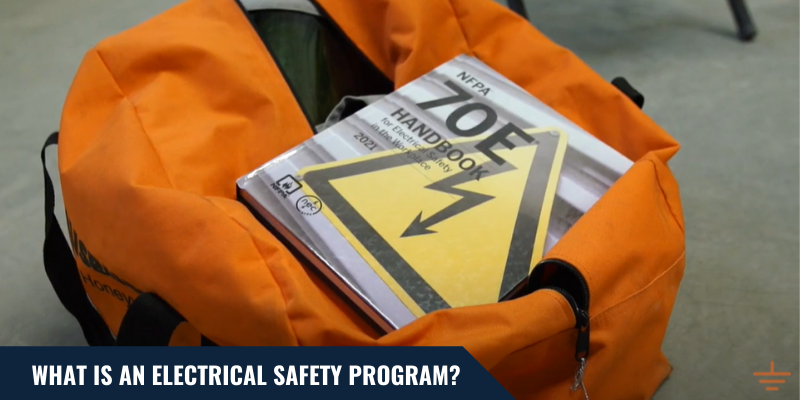For employers, engineers, and safety managers, creating a workplace where team members know how to approach electrical hazards is a top priority. NFPA 70E offers standards and guidelines to build out an effective electrical safety program and provides procedures for energized work to be performed, based on electrical safety rules established by OSHA.
A comprehensive electrical safety program ONLY works when employees uphold the best safety practices, and everyone is held accountable for safety. Your program should be developed specific to your work environment and appropriate for voltage, energy levels, and circuit conditions.
Read this full article and others like it HERE in the Winter 2022 issue of Electrical Safety in the Workplace Magazine.
The foundation of an effective electrical safety program is a thorough arc flash study that analyzes all potential hazards and provides employees the information to make the right safety decisions.
NFPA 70E breaks down electrical safety programs into five (5) parts:
- PRINCIPLES
- CONTROLS
- PROCEDURES
- HAZARDS / RISK ANALYSIS
- AUDITS
Hazards/risk analysis provides the data procedures are developed around, then work in combination with the employees’ control methods and safety principles. Procedures should be designed for each specific task. While the hierarchy of risk controls (HORC) outline six general methods for controlling electrical hazards and can be explored in more detail in the NFPA 70E.
There are two (2) methods of hazard/risk analysis that can be used- The PPE Category Method or the Incident Energy Method.
- The PPE Category Method is used in cases when an arc flash study has not been performed and equipment is not labeled with the arc flash incident energy. Before doing any live electrical work, calculations nerf to be made on the spot to determine the proper PPE category for the job at hand.
- The Incident Energy Method is more efficient and reliable than the PPE category method. When using the incident energy method, a comprehensive arc flash study is performed, then all calculations are generated, and electrical equipment and panels are labeled so the workers do not have to perform the calculations themselves. Labels display the incident energy level that tells employees the precise PPE rating to suit up in before performing the work.
Audits are a regular part of any electrical safety program and make certain that workers have the ability to perform their jobs on par with established procedures. Programs should outline the way team members will be evaluated on their adherence to safety principles. OSHA and NFPA require annual audits and updates on a three-year code cycle.
The goal of every comprehensive electrical safety program is protecting employees from shock, burn, blast, and other hazards. By addressing the following areas, your program will be up to NFPA recommendations.
CREATING YOUR PROGRAM
First, your safety program should be standardized and written out, with proper lockout/tagout procedures.
Then, it’s important to keep up with training, as follows:
- Safety training for Qualified electrical workers | EVERY THREE (3) YEARS
- Contact release training | ANNUALLY
- Arc flash studies | EVERY FIVE (5) YEARS
The alternative is utilizing the PPE category method each time work is performed, but that can be tedious.
PPE accessibility is critical to keeping team members safe-
- Voltage rated gloves must be available and switched out EVERY SIX (6) MONTHS to ensure performance.
- Arc Flash PPE must be available for work on high energy panels, whether it’s part of a worker’s regular uniform or additional protective layers needed for the job.
- All equipment should be kept up to date, accessible, and maintained.
FINALLY, NO WORKER SHOULD PERFORM ELECTRICAL WORK UNLESS THEY’RE QUALIFIED FOR THE PROJECT AND CURRENT WITH THEIR TRAINING. It’s important that electrical safety programs detail the training required for each task.
Always ensure the right PPE and tools are used on the job and the PPE category method or incident energy method is used when performing hazard/risk analysis for work on or near energized lines. Electrical shock ratings and arc flash should always be part of hazard/risk analysis, whether the PPE or incident energy method is used.
THE BENEFITS OF A THOROUGH PROGRAM
A comprehensive electrical safety program will also help protect your property and equipment. General housekeeping keeps equipment clean and free of debris and can save money in the long run.
- Checking for exposed live parts can help prevent accidents. Live parts should always be properly contained. Make sure no panels are missing breakers, panel blanks, or cut-out holes, and junction boxes are not missing covers.
- Establish proper working clearances based on equipment voltage class. Qualified team members should be able to work safely around equipment and steer unqualified employees clear of the area. Equipment needs to be properly spaced to comply with NEC.
- Regular maintenance, like testing, commissioning, and regularly scheduled shut downs for cleaning are crucial. Infrared scanning can be used to locate hotspots within electrical systems and direct maintenance needs.
- Voltage markings should be clearly visible on panels, and panels should be named in an organized way on electrical schematics.
Communication is another key component of every comprehensive electrical safety program. Each job should be established the first time a task is performed.
NFPA 70E requires briefings for each task, so employees are aware of hazards, procedures, controls, and the PPE they’ll need. When a task is complex or highly hazardous, a more thorough discussion may be necessary. Hazards should always be the focal point because they might not always be apparent to the worker.
When it’s time to engage in electrical work, all equipment should be inspected to ensure the insulation and integrity of enclosures. CONSIDER ALL EQUIPMENT ENERGIZED UNTIL AN ELECTRICALLY SAFE WORK CONDITION HAS BEEN ESTABLISHED WITH THE METHODS DETAILED IN THE NFPA 70 E.
If it’s necessary to perform energized work, it’s important to use established procedures and proper PPE. Document all energized tasks on work permits approved by a safety manager.
Designing a comprehensive electrical safety program takes effort and diligence. Starting with a thorough arc flash study as the foundation, proper hazard/risk analysis, development of controls and procedures, maintenance, and communication make your facility safe for everyone on your team.
Don’t forget to subscribe to our blog to get notified when we publish a new article!

Dave Hernandez, PE, CEM, GBE, CESCP is a distinguished Professional Engineer licensed in 52 U.S. jurisdictions and serves as the Chief Operating Officer at Electrical Power & Safety Co. (https://epsco. co), a world leader in electrical safety. He has overseen over 20,000 electrical projects, sits on various industry committees, and has published several white papers.



